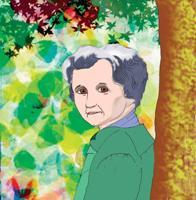- Region Summary News
- 25th Anniversary
- 2011-2013 and Beyond...
- Participate
- testing
- Photos: World Oneness Aspiration Themes
- Torch-Bearer Award
- Videos
- Friends
- UN Initiatives
- Media
- Year - Rapprochement of Cultures
- Davidson Hepburn Message
- Other IYRC Messages and Statements
- Examples of IYRC at Events
- Living in Harmony - Summer Camp Curriculum
- Introduction, Dedication, Contents, Note to Camp Teachers
- Chapter One ...Imagination
- Chapter Two...Building Harmony through Affirmations
- Chapter Three...Feel and Express Harmony through Art
- Chapter Four...Good Things about Ourselves - Our Virtues
- Chapter Five...Fitness
- Chapter Six ...Involvement with Nature
- Chapter Seven...Love Starts Here: Building a Just and Peaceful World
- Afterword .....To students, teachers, and parants -
- NYC Recreation Centers - Day Camps
- IYRC Logo: 6 Languages, Multicolor strands and symbol
- Sample Handout - Message, Song Music, Country list, Photos
- IYRC Talking Points and FAQ
- "How to" show IYRC at "Live from Road" news
- Schools And Kids
- Song
- About
- Asia Pacific
Chapter Six ...Involvement with Nature
LIVING IN HARMONY - Chapter Six
Empowering Children to Become World Harmony Builders
Involvement with Nature
Chapter Inspiration:
―Climb the mountains and get their good tidings. Nature‘s peace will flow into you as sunshine flows into trees. The winds will blow their own freshness into you, and the storms their energy, while cares will drop away from you like the leaves of Autumn.‖ –John Muir
―I believe in God, only I spell it Nature.‖ –Frank Lloyd Wright
―The aim of life is self-development. To realize one‘s nature perfectly – that is what each of us is here for.‖ –Oscar Wilde
―Wake up, look around and see the blossoming of a totally new world.‖ —Sri Chinmoy
―In all things of nature there is something of the marvelous.‖ –Aristotle
―Nature does nothing uselessly.‖ –Aristotle
―Think not disdainfully of death, but look on it with favor; for even death is one of the things that Nature wills.‖ —Marcus Aurelius Antoninus
―In the state of nature ... all men are born equal, but they cannot continue in this equality, society makes them lose it, and they recover it only by protection of the law.‖ —Charles de Montesquieu
Chapter Story:
Rachel Louise Carson was born in the small, river town of Springdale, Pennsylvania, in 1907. Rachel‘s mother was a great lover of nature and living things, and so Rachel spent much of her childhood outside in nature and talking about the natural world with her mother. In school, Rachel loved science and she went on to study science in college. She received a Bachelor‘s Degree in Biology from Pennsylvania College for Women and a Masters Degree in Zoology from John‘s Hopkins University.
Rachel Carson became famous as a naturalist and science writer for the public. She resigned her job in government service in 1952 to devote herself to writing. During her career as a writer, Rachel wrote several other articles that were intended to teach people about the wonders of the living world. All of Rachel‘s writing expressed the philosophy that human beings were only one part of nature and that human beings had a power that other living things did not have – human beings could either help nature or hurt nature.
Around the time of World War II, Rachel became very concerned about the widespread use of pesticides around the world and the dangerous impact of chemicals on the environment, on animals, and on people. Rachel felt a responsibility to warn people that the chemicals in pesticides were very harmful and that something had to be done to protect people and nature from them. In 1962 she wrote a book called Silent Spring, in which she spoke out against the practices of agricultural scientists and the government. In this book, Rachel called for a change in the way people were viewing and treating the natural world.
Some people did not like what Rachel was saying, especially the companies that made the chemicals for the pesticides. Rachel was criticized and sometimes ridiculed by the chemical industry and by some members of the government. Yet Rachel continued to speak out about what she believed and about what her scientific research was showing. She continued to try to teach people to see humanity as part of the fabric of nature, and that if we treat nature badly, we will all suffer in the end. In 1963 Rachel was called to testify before Congress, and during her testimony she pleaded for new policies to protect people and the environment from dangerous chemicals.
Rachel Carson died from breast cancer in 1964. Her work lives on in her books. Her life is an inspiration to all of us to try to be more aware of our capacity to live more harmoniously with nature.
Chapter Overview:
Living in harmony with Nature is one of our most important jobs as human beings. As Rachel Carson and many others have taught us, we human beings are the stewards of the earth. We have a very important responsibility to treat the earth kindly, to use the earth‘s resources wisely, and to preserve the beauty and health of the earth for the future. Nature herself can provide us with comfort and support as we try to live up to our responsibility. When we need guidance, wisdom, or inspiration, we can go out into nature to play, walk, run, write, paint, sing, or just to be.
There is a great harmony that exists in nature. As creatures that are a part of nature, we can enjoy that harmony and that connection every time we go out into the forest, to the mountains, to the sea, or just to a local meadow, a park, or our back yard. Nature is one of our most special friends. It is important that we get to know nature‘s gifts so we can get help and healing from nature when we need it – and so we can support nature when she needs our help.
Chapter Lessons:
Lesson #1 — Plant a Tree for World Harmony
Draw a tree and label all the leaves with a different word or picture that describes how a harmonious world looks like. Now think about what virtues or good qualities each of us will need in order to create the world represented by the tree and write or draw these qualities around the tree. Just like a tree needs water, air, earth and sunlight to grow world harmony needs to be lovingly and carefully grown through all our individual efforts to live in harmony. You may want to discuss with the class what you think harmony means – how it feels and what it looks like and then to display the tree drawings around the room after you finish.
Now you are ready to plant your world harmony seed. Summer is not a good time for planting trees but you can plant a flower or any other small plant. Just like world harmony the seed or little plant will start out small and not so strong. But as you visit it and care for it every day it will grow bigger and stronger. Before you finish planting find a little stone. Hold the stone in your hands near your invisible heart and make a secret wish for harmony – where you think it is needed most. Then as you cover the seed or the roots of your little plant with soil – add the little stone at the bottom. Your wish will grow with the plant. (If your plant doesn’t make it through the season don’t worry – your wish will keep growing secretly and silently on its own)
Lesson #2 — Mini Vision Quest
If possible, the vision quest should take place in a natural setting such as your local park, a nature center, or even to a quiet spot on your playground. Vision quests were and continue to be an important coming of age ceremony in many native tribes of North America. In many Native American tribes, a young person in the early teen years goes out into nature and spends some time by themselves. Sometimes they may even spend a night, or even two or three nights, alone in the wilderness. During this time the young person is expected to practice the skills of living in the wilderness that they have learned, and they are also supposed to spend time in reflection about this important stage of their lives.
When you do your own vision quests, you will not be staying in the wilderness alone for a long time as the young Native Americans do. You will simply go to spend some time in a natural place. Here are a few guidelines you might find helpful for a successful vision quest:
a) Take the class to a natural place or to a local park.
b) Each student should bring a pen or pencil and a small notebook to write or draw in. A marble composition book is fine, though a smaller, pocket-sized notebook is even better.
c) Each student should be prepared to be silent for at least 15 minutes. 30 minutes of silence is ideal. It might be very helpful to practice being silent in class for some minutes each day prior to going on your vision quest.
d) Once you arrive at your natural location, each student should pick a different spot to be. They should select a spot that ‗speaks to them‘ – a place where they will be comfortable and peaceful and not distracted. It is important for each student to be far enough from other students that they can‘t really see them directly or at least that they can‘t really talk to each other.
(Note: an absolutely ideal spot for a vision quest is along a stream where each person can find his or her own spot. The rushing of the water helps to create a private place for each person where they can‘t really hear any outside noise.)
e) During the vision quest everyone should maintain silence. If someone needs the teacher‘s attention for some important reason, they can make a signal or a motion to the teacher and the teacher can quietly come over to the student.
f) The teacher‘s job is to walk around quietly and unobtrusively, to make sure everyone is safe and focused. If everything is going as planned the teacher can sit in a central place and enjoy nature too!
g) Each person should be encouraged to pay attention to the things of nature that surround them – especially the small things. Look and listen to the sights and sounds of nature – the songs of the birds, the rush of the water, the insects on the ground, the flowers, the ferns, the grass and the trees.
h) Each student should be encouraged to listen with their inner ears and to look with their mind‘s eye during their vision quest. If they do, they very likely will get a message or an image that they want to write down or draw in their notebooks.
i) Sometimes it is best to advise the students to wait until they get back to class to share about their vision quests. This gives each person time to think about and absorb their own experience.
j) Once back at school, invite students to share about their vision quests if they want to. Students should also be invited to write more in-depth journal entries or more detailed pictures once they are back in class. This will make their overall experience much deeper and more memorable. Enjoy your vision quest!
Lesson # 3 —Nature poem/Circle game
For this game you will need some special things that you have found in nature – some small stones, some shells, some chestnuts, black walnuts in their green shells, or some other roundish natural objects. You can use apples, oranges, or ordinary balls if you wish. It is quite possible that a few objects will be dropped and lost to the game, so plan accordingly. You should have enough items of the same object, all stones or all shells, for example, so everyone in the circle will have one.
a) For this game, stand in a circle with just enough distance between each person so that everyone can touch hands. During this game you don‘t actually hold hands, but you gently touch each other‘s hands by holding your left palm upward and your right palm downward. Eventually you will be receiving an object in your left hand from the person to your left and you will be passing the object on to the person to your right with your right hand.
b) You begin the game, however, with each person holding their object in their own two hands in front of their invisible heart – the left hand palm up and the right hand palm down. In other words, the object will be sitting in the left palm and it will be covered gently by the right hand.
c) You will stand still during this game. The only motion is with your hands and arms. Basically there are only two motions. In one motion you are moving your hands towards your neighbors‘ hands on your left and right. In the other motion, you are moving your hands back to the middle of your chest, as described above. First you will receive an object in your left hand, then you will move your hands to the middle of your chest, and then you will pass the object to the person on the right.
d) It is important to keep a steady rhythm. Otherwise folks will not pass at the same time. In other words, everyone in the circle needs to do the actions in unison – that is the object of the game. If you think of each motion described above as having one drumbeat, this will help you to ‗get it.‘
e) There is a poem that goes with the game. Wherever you see the slash (‗/‘) in the poem, that is where your hands are coming to the center. Whenever you are saying the words of the poem, that is where you are receiving or giving the object. It is important to pause briefly after every motion – after every part of the poem. Each part of the poem goes with one beat. Here is the poem:
We give / we care
We learn / to share
And as / we give
We learn / to weave
A web / of love
As bright /as stars
That shine / above
f) When you are done with the game, you can talk about the game – what was challenging and what was fun. You can also talk about the meaning of the poem.
This poem is borrowed from the Rudolph Steiner educational program – also called the Waldorf educational approach.
g) You may find it very helpful to practice this game without any objects first, so you can learn the motions, the proper rhythm, and the words to the poem.
Discussion Questions:
a) Compare the two meanings of ‗nature.‘ One meaning is Mother Earth and all of her manifestations. The other meaning means the essence of being human. Can you find one quotation from the chapter quotations above that uses ‗nature‘ in the first way and another quotation that uses ‗nature‘ in the second way? How do you think these two kinds of nature are connected? Brainstorm the different ways – there is not just one ‗right‘ answer!
b) Frank Lloyd Wright was a very famous American architect and philosopher.
Discuss what you think he meant in quotation #2.
Supplemental Activities:
The silent nature adventure
For this lesson we will go on a special adventure in the forest or on our playground. We will go on a walk and as we walk we will pay special attention to what we are experiencing though our senses. For a period of time we will not talk at all. The goal of our nature adventure is to experience nature without words. After our silent nature adventure we will have a chance to draw and write about our experiences. We will also share with each other about what we learned.
a) With our ears we will pay attention to any insects or birds we might hear. If we are near a river or stream, we may hear running water. If we are lucky we may hear some animals such as the chirping of squirrels or chipmunks. We may also hear some sounds that are made by humans and not nature.
b) With our eyes we can observe things as big as the sky and as small as bugs eating a stump. We might observe a bird building its nest, caring for its young, or speeding through the trees. We might observe a butterfly or a honeybee going from flower to flower gathering nectar and pollinating the plants. We might observe many other things.
c) With our sense of smell we can smell the fragrance of the flowers, or of the earth after a rain, or of the skunk cabbage in a swamp. If we pay close attention we can also tell the difference between the smell of the deep forest compared with the smell near a stream or river, or compared with a meadow.
d) With our sense of touch we can feel a stone. We can feel the cool, soft water of a stream or the warm water of a pond. We can touch the grass. We can hug a tree and feel the bark around it. We can see how soft a dandelion can be and we can carefully feel how sharp is the thorn of a thistle or a rose. We can also feel the air on our faces or on our hands if we hold them outstretched to our sides as we walk.
e) With our sense of taste we might be able to taste some mint growing in a garden. Why not taste a blade of grass, or, better yet, a strand of hay growing in the field? If you gently munch down on the hay you can taste the sweet green juice inside. If there is a honeysuckle bush nearby, we can taste the sweet nectar that is inside by pulling very gently on the white stamen and licking the tiny bubble at the end before it falls off. Garden vegetables are always a wonder to taste if we have the chance. With wild plants in the forest, we should never taste anything without direct adult supervision and permission.
some examples of the World harmnoy Run events in nature:
China:
For full report of day 2010 May 09 see:http://www.worldharmonyrun.org/china/news/2010/0509a
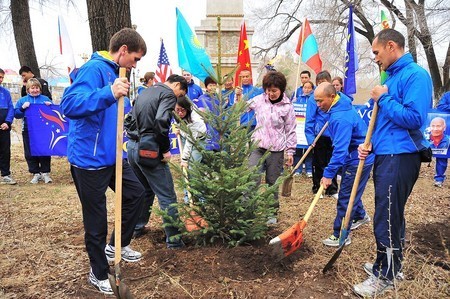
Representatives of five countries planting a peace tree
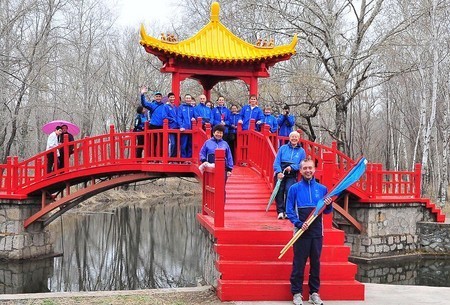
Team on an ancient ‘triadic’ bridge.
Mongolia:
Khavirga Border Point (Хавирга боомт). For Report of day 2010 May 15 see:
http://www.worldharmonyrun.org/mongolia/news/2010/0515
Border chiefs and staff warmly welcome international team of runners.
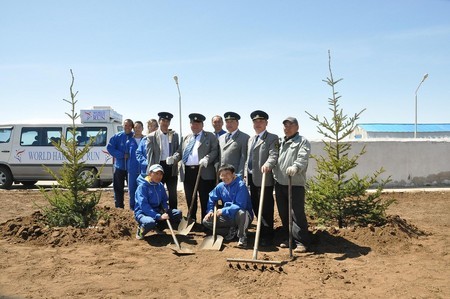
Гүйлтийн багийнхан болон гаалийн ажилтнууд хамтдаа хил дээр эв найрамдлын 4 мод суулгалаа.
Four peace trees were planted by border staff and Harmony Run members.
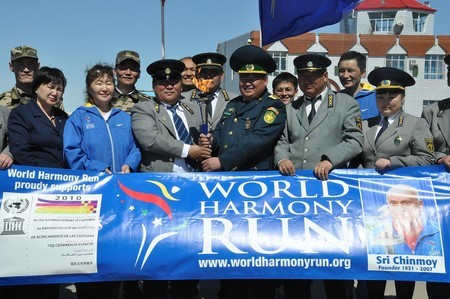
Share torch with 2010 banner at the starting point of 2,600 kilometer journey with Torch of Harmony and Peace in Mongolia.
Canada
Full of inspiration from the ceremony on Parliament Hill, it was now our turn to run with the Torch. We set out for the Rideau Canal, a UNESCO World Heritage Site, nestled below the embankment of Parliament Hill.
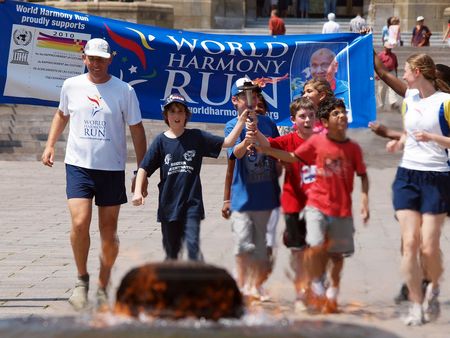
The blue sky and the blazing sun made for a 34 degree near record setting temperature run, the kids did not seem to notice the heat.
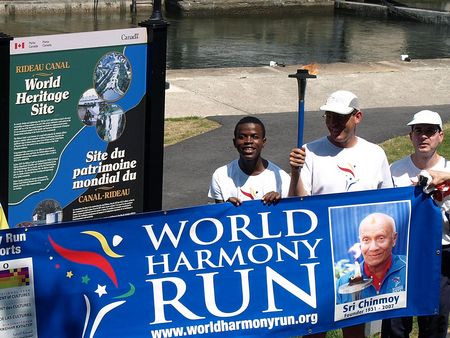
Our first break at the Rideau Canal, UNESCO World Heritage Site.Then we ran along the beautiful Confederation Boulevard loop which circles between Quebec and Ontario.

Austria -Child leads to Peace Bridge,
For full report see: 3 June: Puchenstuben - Ternberg
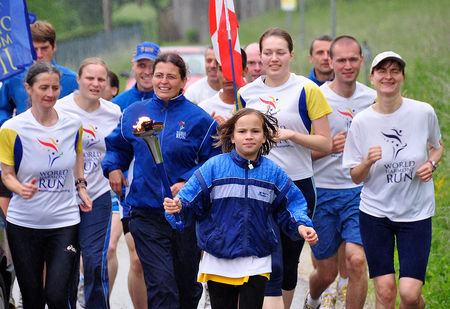
Shortly before we reached Reichraming, a little girl from the community, very eager to hold the torch, accompanied us to town.
She showed us the way to an especially significant location - a Peace-bridge, built by young people from Austria, Israel and Palestine, symbolising hope of Israel and Palestine living together harmoniously in the future.
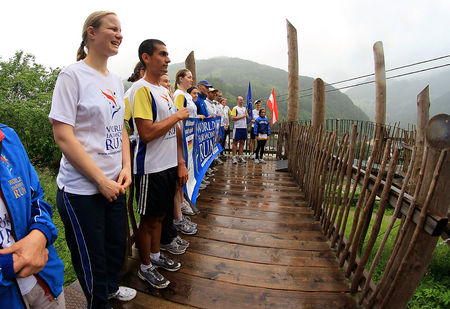
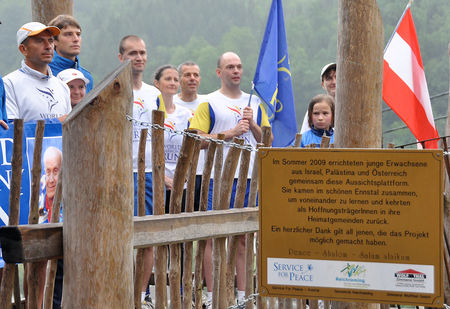
An exceptionally warm and heartfelt reception followed.
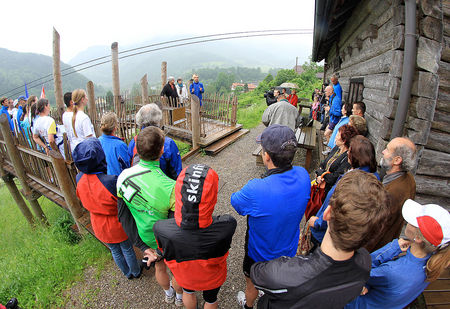
People from the community, both runners and non-runners, had gathered...The Mayor welcomed us warmly, and spoke about the history of the community and its projects and efforts for fostering peace and Harmony in the Community.
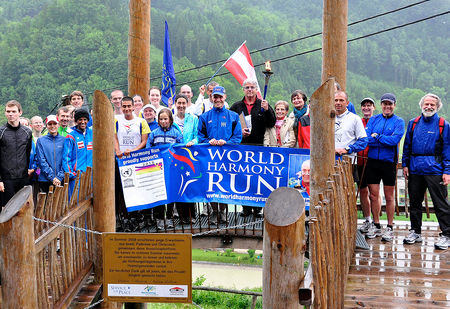
There was a real feeling of unity..on this symbolic and hopeful bridge in the midst of beautiful nature...
USA Utah - Arizona
USA - Bluff, UT - Tsegi, AZ
for a full report of 01 June see: http://www.worldharmonyrun.org/usa/news/2010/week07/0601
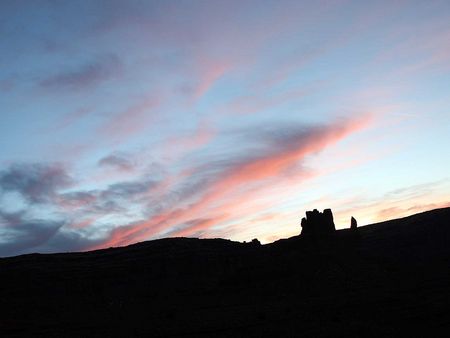
This morning a few of the team began the day with a morning watching the sunrise in Valley of the Gods. As always, it was truly beautiful.
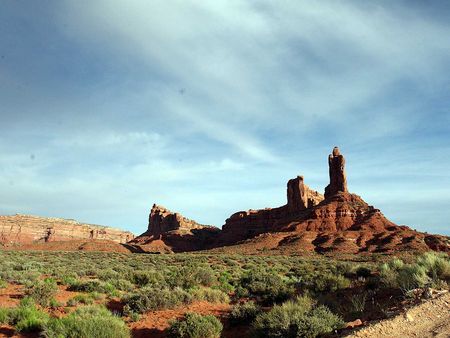

There has been lots of rain out here so there are wild flowers in abundance.
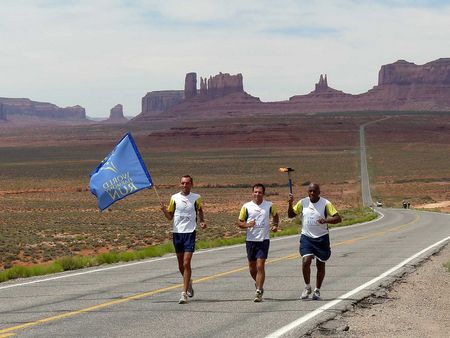
This is the famous place where Forrest Gump said he was going to turn around. This team kept going especially to see the children and young at heart waiting for the run up ahead.
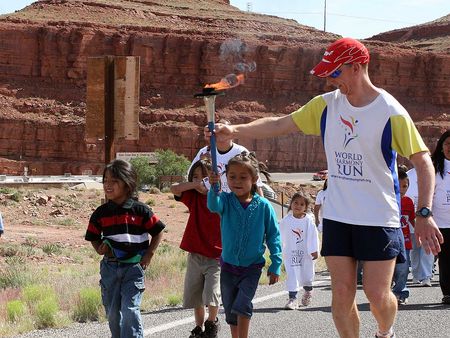
Monument Valley
Our first appointment was with the children of the Monument Valley Head Start Program who ran with us.
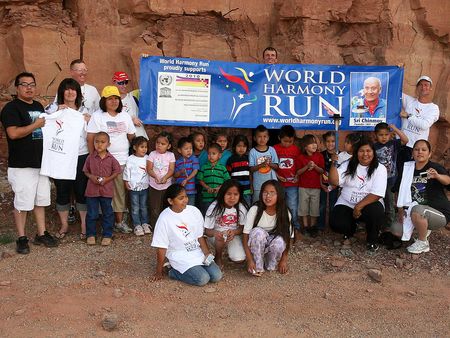
Navaho reservation.
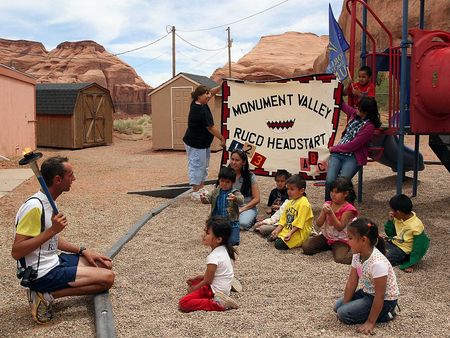
Our next stop was at a school on a Navaho reservation. We were greeted by adorable children from the Rural Utah Head Start Program.
Performing the World Harmony Run song.
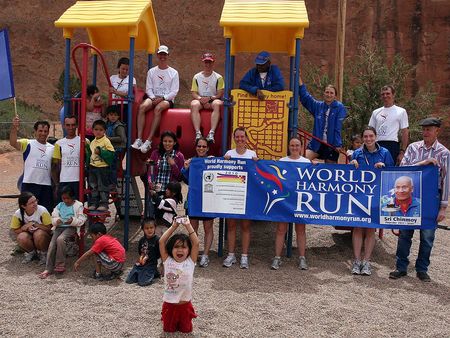
and watching others
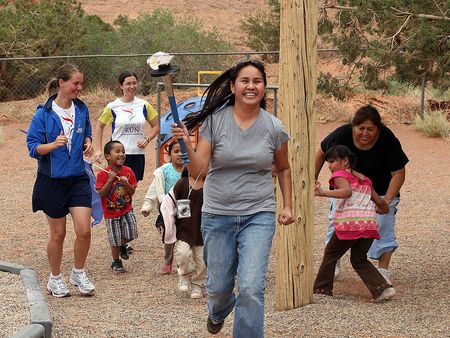
After the the ceremony the women's team started a long afternoon run. They were scheduled to run the next 40 miles of the route.
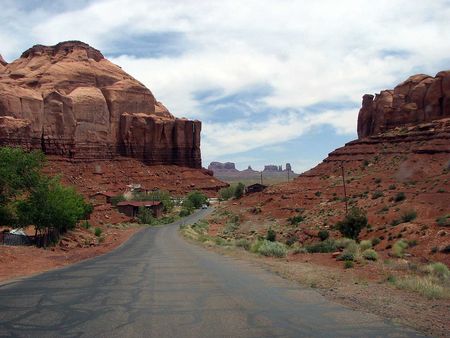
We camped the night at Gouldings and this was our view.
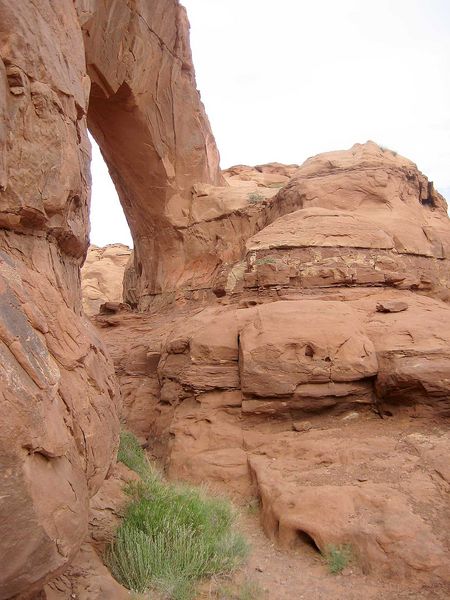
A natural arch right by our campsite - stunning. Some of us slept on the rocks under the stars.
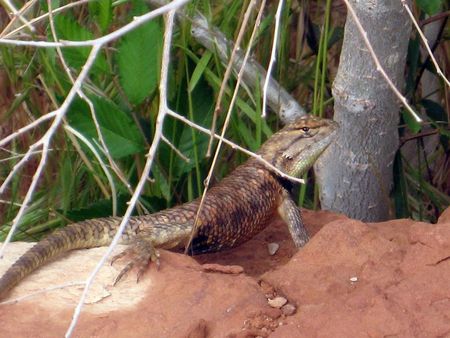
One of our camping friends.
This is one of the most scenic days on our entire trip..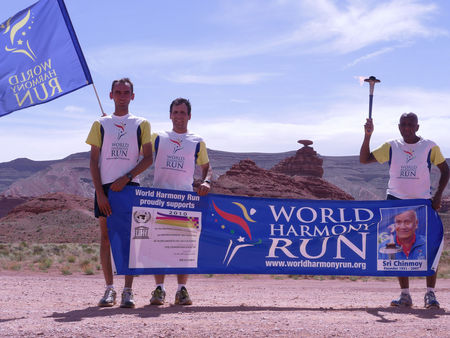
Mexican Hat.
Nova Scotia, Canada - Halifax for full report of 10 june go to: http://www.worldharmonyrun.org/canada/news/2010/0610

At Riverside Education Center, the students formed a circle in the field, and linked arms in a sign of harmony.
Some people came to hold torch together after we spoke of the 6 languages on the banner. This followed a part in programme where some from the group had volunteered to come up

- To represent one of the less familiar languages on the 2010 logo such as when Spanish, Russian, Chinese or Arabic were mentioned.
We also discussed others languages that might be added,
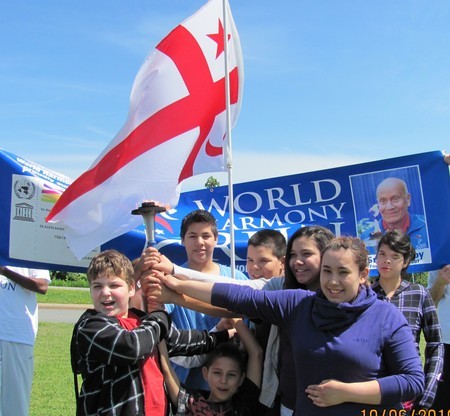
In INDIAN BROOK, LSK (L’nu Sipuk Kina’muoKuom)
Sudents took the torch and ran it strongly up the hill with their flag and the banner

Musical Welcome
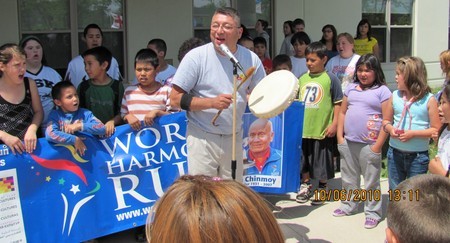
The World Harmony Run was greeted with the Mi’kmaq gathering song beautifully and enthusiastically.

Even the landscape today in Nova Scotia offered us a special Serenity message.
Peggy's Cove and Lighthouse A team member remembered that the Harmony run in 2008 had gone by the scenic Peggy's Cove. So the next day some local and international runners visited with the new banner.

- There were stunning views from the rocks with the sound of crashing surf.
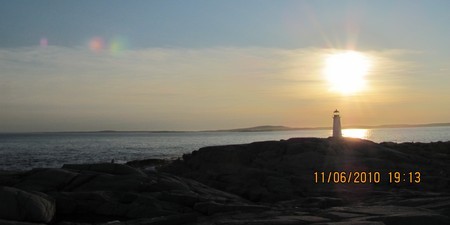
- The beautiful lighthouse with the sun beginning to set.

- Invited us for a closer look with the banner.
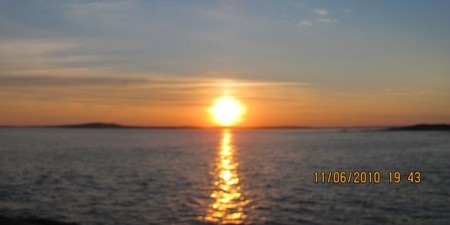
- From there we took in the beautiful oneness and uniqueness of the sky, sun and sea.
For art and nature see: Hungary - Full Day event in Budapest
- Many thousands of children made drawings on the theme of harmony and "reverence for Mother Nature."
- Paper in shape of a huge tree was alive with activity and color.























